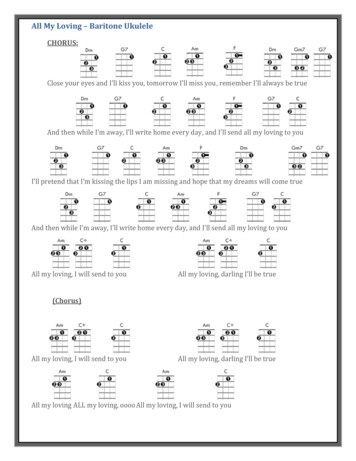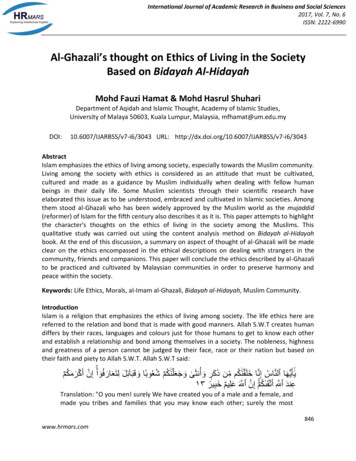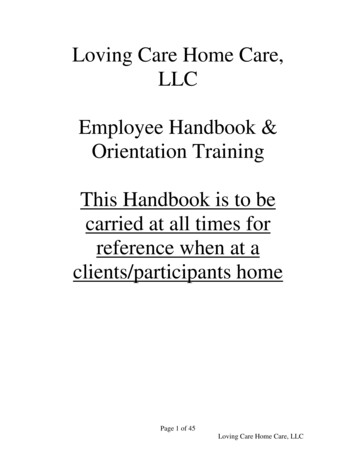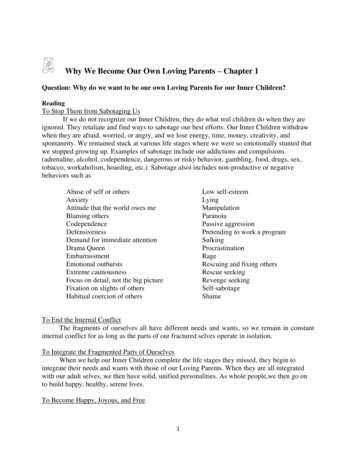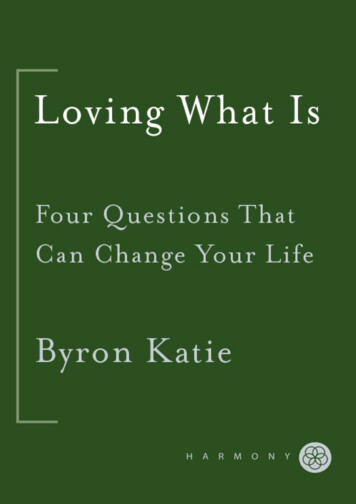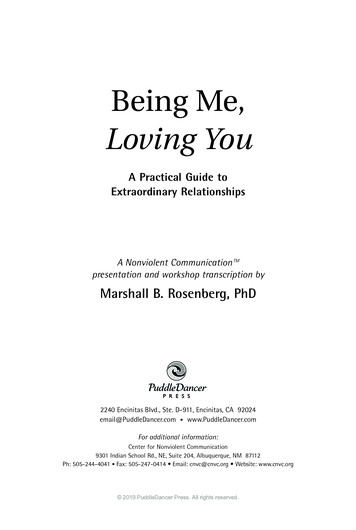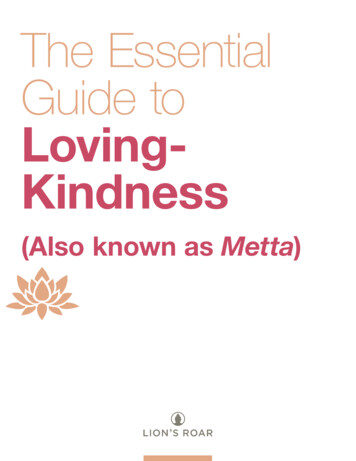
Transcription
The EssentialGuide toLovingKindness(Also known as Metta)
Copyright 2022 Lion’s Roar Foundation, except where noted. All rights reserved.Lion’s Roar is an independent non-profit whose mission is to communicateBuddhist wisdom and practices in order to benefit people’s lives, and to supportthe development of Buddhism in the modern world. Projects of Lion’s Roar includeLion’s Roar magazine, Buddhadharma: The Practitioner’s Quarterly, lionsroar.com,and Lion’s Roar Special Editions and Online Learning.
CONTENTSMay All Beings Be at Ease!How to Practice Loving-Kindness JoAnna HardyWhy I do Metta Janice Lynne LundyLoving-Kindness Starts With You Josh KordaSharon Salzberg’s Aha! Moment As told to Lindsay KyteHow to Practice Metta for a Troubled Time Mushim Patricia IkedaMeet Bad Habits with Loving-Kindness Sylvia BoorsteinLoving-Kindness Healing Your Inner Child Peggy Rowe Ward andLarry WardHow to Practice Metta With Children Gail SilverMetta for Refugees Liên ShuttLoving the Many Sides of You Susan Piver
May All Beings Be at Ease!Metta—kindness or goodwill—is one of Buddhism’smost valued virtues. With compassion, empathetic joy,and equanimity, it is one of the four “divine abodes”(brahmaviharas) of the enlightened ones.In the Metta Sutta, the Buddha teaches his monks how to live amoral and upright life, with metta at its center. In these stanzas,he tells us how to live with complete kindness.Whatever living beings there may be;Whether they are weak or strong, omitting none,The great or the mighty, medium, short or small,The seen and the unseen,Those living near and far away,Those born and to-be-born,May all beings be at ease!Let none deceive another,Or despise any being in any state.Let none through anger or ill-willWish harm upon another.Even as a mother protects with her lifeHer child, her only child,4THE ESSENTIAL GUIDE TO LOVING - KINDNESSLIONSROAR .COM
MAY ALL BEINGS BE AT EASE!So with a boundless heartShould one cherish all living beings:Radiating kindness over the entire worldSpreading upwards to the skies,And downwards to the depths;Outwards and unbounded,Freed from hatred and ill-will.Whether standing or walking, seated or lying down,Free from drowsiness,One should sustain this mindfulness.This is said to be the sublime abiding.From “Karaniya Metta Sutta: The Buddha’s Words on Loving-Kindness”(Sn 1.8), translated from the Pali by The Amaravati Sangha. Access toInsight (BCBS Edition), 2 November 2013,5THE ESSENTIAL GUIDE TO LOVING - KINDNESSLIONSROAR .COM
HOW TO PR ACTICE LOVING - KINDNES BY JOANNA HARDYHow to Practice Loving-KindnessJoAnna Hardy teaches us the famed Buddhist practice ofmetta—offering love to ourselves and others.When I was introduced to the practice of metta—most oftentranslated as loving-kindness practice—I definitely knew it wasn’tfor me. It was too mushy and sentimental for my pragmatic mind.It was reminiscent of the wishful praying that I thought wasreserved for the type of faith I had left behind.I didn’t really believe that I—or maybe any living being—couldpossibly find the happiness, safety, ease, and freedom beingoffered through metta practice. Maybe we didn’t even deserveit! When I put my hand on my heart, as we are often asked to doduring this practice, I felt numb and disconnected. I thought ofloving-kindness as an unnecessary additive to the more importantfour foundations of mindfulness. I ignored the practice for manyyears.Then, a wise and insightful teacher saw me struggling andassigned metta as my daily practice for three months. It wasn’tbecause my teacher thought I was not a kind and loving person—Iam—but I needed a way to love all beings, and to offer that love tomyself too.6THE ESSENTIAL GUIDE TO LOVING - KINDNESSLIONSROAR .COM
HOW TO PR ACTICE LOVING - KINDNES BY JOANNA HARDYI discovered that while loving-kindness is taught in many waysby different teachers, ultimately it is an equalizer and an antidoteto hatred and aversion. It is a state that can be developed throughpractices that help us cultivate the unconditional, expansive qualities of the heart. Metta is the great balancer to insight and mindfulness practices.When I discovered other translations of the word metta, likecare, friendliness, goodwill, and benevolence, the practice beganto feel more accessible and less lofty. Metta felt like something Icould touch and cultivate daily. The great balancer began to do itswork. My doubt began to melt.In trying times such as these, it seems difficult to imagine thatwe could soften our hearts and find love amid all of the sufferingwe hear about daily. Yet, the prescription of the Buddha is thateven in the darkest of places and times, our heart-mind has thecapacity to be free from the burdens of hatred.Here is a four-step instruction for metta. These steps are forpracticing loving-kindness for yourself. You can also practicemetta for others in different categories, such as people close toyou, friends, people you are neutral toward, people you find difficult, and ultimately all living beings.Initially, set aside 15-20 minutes to do the four steps. As youdevelop your practice, you can add more time as you wish. Settinga timer is helpful.1. Put your body at ease.Find a physically comfortable space. Sitting in a comfortable chairor lying down is helpful. If you feel at ease on a meditation cushion, that is fine too. The idea is to find a posture that allows the7THE ESSENTIAL GUIDE TO LOVING - KINDNESSLIONSROAR .COM
HOW TO PR ACTICE LOVING - KINDNES BY JOANNA HARDYbody to be in as much ease as possible. Allow yourself to feel heldand supported by whatever you’re sitting or lying on. Closing theeyes can help to facilitate ease. If that’s not comfortable, thenallow the eyes to be open and gazing softly at a singular point.2. Soften the belly and chest.Intentionally soften the belly to start. Feel the expansion and contraction as each breath fills the belly and chest area. Allow yourbreathing to facilitate space in your belly and chest area. Takeyour time; there’s no rush. If you feel tension, that’s okay.3. Recall feelings of love and kindness.Focus on the heart area. Placing your hand on your heart can addto this step. See if you can recall feelings of care, kindness, andfriendliness. Let them permeate your heart area. Stay with thiswhile moving into the next step. If the feelings seem inaccessibleor difficult right now, stay with the spaciousness and breathinginto the belly and chest areas.4. Do the recitation.Reciting phrases is a classic way of practicing metta. Whether webelieve the phrases in the moment or not, it’s still useful to saythem; they give the heart and mind something to land on and toaspire to. You can express them in any way you want, with thesebasic sentiments in mind. Repeat these phrases for the length ofyour practice period:8THE ESSENTIAL GUIDE TO LOVING - KINDNESSLIONSROAR .COM
HOW TO PR ACTICE LOVING - KINDNES BY JOANNA HARDYMay I be safeMay I be healthyMay I be happyMay I be at easeMay I be filled with loving-kindnessMay I be peacefulIn metta practice, it is normal for the doubting mind to pop upand challenge the notion of loving ourselves and others. Don’t letthis doubt stop you. It is important to know that metta is not apractice of perfection, but one of cultivation. This is our practice—freeing our heart and mind from the clutches of fear, hatred, andconfusion, regardless of what is happening in the world around us.I am happy to report, after trying it myself, that this skeptic is nowconvinced!JoAnna Hardy practices in the Theravada Insight tradition, with a focuson teaching meditation in communities dedicated to seeing the truth ofhow racism, gender inequality, and oppression go hand in hand with thecompassionate-action teachings in Buddhism. She is leader of the Lion’sRoar Online Learning course, How to Cultivate a Loving Heart: The Buddhist Practice of Metta.9THE ESSENTIAL GUIDE TO LOVING - KINDNESSLIONSROAR .COM
“Why I Do Metta”Author and educator Janice Lynne Lundy shares herperspective on the practice of loving-kindness meditation—why she loves it, and why it goes with her everywhere.My favorite form of meditation is “Metta,” or loving-kindnesspractice. Here’s why: When I say the four phrases of blessing, first,for myself May I be happy.May I be healthy and strong.May I be safe.May I be peaceful and at ease.10THE ESSENTIAL GUIDE TO LOVING - KINDNESSLIONSROAR .COM
WHY I DO METTA BY JANICE LYNNE LUNDY. I remember that it is good to be kind to myself; to holdmyself in loving embrace as I am; to be gentle, open, forgiving, andaccepting.When I repeat the four phrases again, it opens me up: to wiseothers, loved ones, friends, you, people I don’t even know, everyone on the planet. Metta helps me connect with your essence,your inner beauty, your pain and suffering. Again, I am softenedinto compassion.I try to take the Metta mindset with me wherever I go; itserves as portable peace. I stand in line at the grocery store,noticing someone’s downcast face.May you find ease and know happiness today.In American Eagle, music blaring, shopping with my teendaughter, I notice a young mother struggling with two babies in astroller. She is trying to shop for herself, yet her children tug andpull. Her frustration grows.May you know patience. May you feel comforted.This morning my husband awoke with his “ego blaring,” as heputs it. I lay my hand on his heart and silently offer Metta to him.My sweetheart, may you be at peace today. May your day unfoldwith ease.11THE ESSENTIAL GUIDE TO LOVING - KINDNESSLIONSROAR .COM
WHY I DO METTA BY JANICE LYNNE LUNDYThis is why I do metta. It lets me lead with love.Today May YOU be happy.May you be well, healthy, and strong for the day ahead.May you be safe and secure.May you be peaceful and at ease with all the circumstances ofyour life.Janice Lynne Lundy is a long-term student of mindfulness and Mettawho sources her life, writing, and teaching in the practice of compassion. She is an Interfaith Spiritual Director/Mentor and the author ofseveral books including, The Mindful Mommy’s Back-to-School SurvivalGuide. She is also the founder and editor of the online magazine/community, “Meditate Like A Girl.” You can connect with Jan via her website:www.JanLundy.com12THE ESSENTIAL GUIDE TO LOVING - KINDNESSLIONSROAR .COM
Loving-Kindness Starts with YouJosh Korda on how to free your naturally loving heartand expand your goodwill to include all beings throughloving-kindness meditation.I haven’t had a drink or a self-prescribed mood-altering drug innineteen years. I make that statement with both pride and wonder, given the amount of suffering that preceded my renunciation of booze, pills, and the like. I mostly attribute my sobrietyto my spiritual practice, the support of my Buddhist community,and our local twelve-step gatherings. But if one practice or toolhas helped me get and stay sober, it is the practice of Metta, orloving-kindness.I grew up in an unpredictable household. My father, an alcoholic, could shift from pleasant joviality to rage-induced violenceover the course of a few glasses of wine. I vividly remember platessuddenly flying toward my head during tense dinners and thesound of my mom’s muffled cries while locked in a bathroom. Inshort, the stuff that leads to years of analysis later in life.13THE ESSENTIAL GUIDE TO LOVING - KINDNESSLIONSROAR .COM
LOVING - KINDNESS STARTS WITH YOU BY JOSH KORDABy my teens I was hypervigilant of others and self-absorbed,the victim of a self-critical inner tyrant. I felt unworthy of others’love and worked hard to hide emotional states my father couldn’ttolerate during his “episodes”—any sign of weakness, frustration,or sadness.My underlying assumption was simple: if others could seethese authentic energies, they wouldn’t accept me either. Yet Idesperately needed emotional tolerance and interpersonal bonding. My life around others became a self-conscious performance.Suppressing so much resulted in an agitated mind, which set meup for addictive behaviors. Alcohol and drugs, I found, relieved thestress created by my concealment and self-judgment.The underlying darkness was kept at bay, until my world fellapart and I wound up in my final detox stint, everything andeveryone lost as a result of my heedlessness.My early days of sobriety were buoyed by the Buddhist practice I had developed over the years. But breath concentration andVipassana practice weren’t enough to deal with my deeply embedded feelings of low self-esteem. The self-critical tyrant remainedon his throne, barking his angry rebukes and rebuttals, which Icontinued to believe, despite having a path in which I cultivatedvirtue and volunteerism. I was deeply despairing and incapable oflasting relationships and deep friendships. And so, when I heardof loving-kindness practice from wonderful teachers like AjahnSucitto and Sharon Salzberg, I dove in.14THE ESSENTIAL GUIDE TO LOVING - KINDNESSLIONSROAR .COM
LOVING - KINDNESS STARTS WITH YOU BY JOSH KORDAMetta is a powerful meditation practice that heals agitatedminds with the development of goodwill toward ourselves andothers. Of great therapeutic benefit, Metta relieves our stressfulthought patterns and can result in immediate improvements inwell-being.How to Do Loving-Kindness MeditationTraditionally, we begin loving-kindness practice by taking a comfortable seat. We can quietly shift positions when necessary, asthis is not a time to investigate physical discomfort.Once seated, we start by inwardly directing loving-kindnessand goodwill to ourselves: perhaps toward a visual sense of ourappearance or toward an area of the body where we experiencecore emotions, such as the chest or abdomen.During initial forays into Metta the mind will often rebel;thoughts critical of the meditation’s value or stories of our unworthiness are swift to arise. All this means is that we need this practice, for, as the Buddha taught, we each deserve goodwill and if wecannot summon it easily for ourselves, we’ll never feel true compassion for other beings.When I first started my loving-kindness practice, developingthoughts of self-regard was a struggle, to say the least. Finallyit occurred to me that I was addressing myself, in my thoughts,in ways I would never address anyone publicly, even those Idetested. I made a pact in my practice that I would say the samethings to myself that a good friend might say. My first choice15THE ESSENTIAL GUIDE TO LOVING - KINDNESSLIONSROAR .COM
LOVING - KINDNESS STARTS WITH YOU BY JOSH KORDAof phrasing was begrudging, along the lines of “I suppose youdeserve some happiness.” It’s a sign of the degree to which I’vehealed that my phrase of choice these days is “I love you, keepgoing.”Once some self-compassion has arisen, we bring to mindimages of friends, mentors, or others we hold in high regard. Thisstage of Metta is generally uncomplicated, requiring little effort,as the admiration we feel for these people naturally results ingoodwill.Next, though, we direct goodwill in more challenging directions. We start with people we are indifferent toward, aboutwhom we have neither positive nor negative feelings. This stagerequires more effort, as the human mind is quite facile at developing opinions about people. Choosing a neutral person—for example, someone we see regularly during a commute or in a store wefrequent—may require memory jogging.Finally, we move to the most challenging stage of Metta practice: radiating goodwill toward those we’ve reviled or struggledwith. (Dick Cheney and the Doobie Brothers almost instantlycome to mind, but maybe that’s just me.) This part of the practice is as essential as developing self-compassion, since holdingresentment is a primary source of agitation and suffering. Thelimits of our goodwill form the ultimate boundaries of our peaceof mind, for we cannot achieve peace while aversion is present.16THE ESSENTIAL GUIDE TO LOVING - KINDNESSLIONSROAR .COM
LOVING - KINDNESS STARTS WITH YOU BY JOSH KORDAThe goal of Metta practice is to free our natural feelings ofbenevolence from their limited confines. Loving-kindness andgoodwill conditioned by agendas or expectations are not deeplybeneficial. In Metta, we work to develop feelings of ease and loveas boundless as the oceans that nourish and sustain our world.Josh Korda has been the teacher at New York Dharma Punx since 2005.He has also taught at New York Zen Center for Contemplative Care andNew York Insight Meditation Center.17THE ESSENTIAL GUIDE TO LOVING - KINDNESSLIONSROAR .COM
Sharon Salzberg’s Aha! MomentRecalling the early days of Barre, Massachusetts’ InsightMeditation Society—of which she was a co-founder—themeditation teacher shares the moment that metta hithome. As told to Lindsay Kyte.It was a time of excitement—and debate. Even the word “metta,”which adorns the entrance at IMS, was a source of controversy.Some people thought they should use an English word, like loving-kindness. “In the end, it just stayed,” says Salzberg, and todaymetta is a recognized term in the Western spiritual vocabulary.There was no programming scheduled for the first month ofIMS’s existence, so Salzberg decided to immerse herself in mettapractice, something she had only done before as a ceremonialending to retreats.“I did it for an entire week and just kept repeating thesephrases, and I felt absolutely nothing,” she says. “Then oneday, I dropped this big glass jar and it shattered and stuff went18THE ESSENTIAL GUIDE TO LOVING - KINDNESSLIONSROAR .COM
SHARON SALZBERG’S AHA! MOMENT BY LINDSAY K Y TEeverywhere. I noticed that the first thought that came up in mymind was, ‘You are really a klutz. But I love you.’ I thought, ‘Look atthat!’ Something was happening.”Salzberg says this is a lesson she’s witnessed over and overagain: “People expect a rush of feeling, like a breakthrough—‘Ifinally loved myself,” or ‘I finally forgave that jerk.’ First of all, Idon’t think things are final, and, more often, it’s a gradual but very,very deep process. Very profound changes happen within you, butthey are much subtler.”Metta and mindfulness became the main focuses of Salzberg’steaching and practice. “I thought of metta as unconditional love. Ihad learned the word ‘loving-kindness’ as the standard translationof metta, but when I’m teaching now I usually say ‘connection’—aprofound sense of connection. It’s knowing somebody counts, thateverybody wants to be happy, and that our lives have somethingto do with one another.”Lindsay Kyte works as a freelance journalist, playwright, and performer.19THE ESSENTIAL GUIDE TO LOVING - KINDNESSLIONSROAR .COM
How to Practice Metta for aTroubled TimeMushim Patricia Ikeda teaches us how to generateloving-kindness and good will as an antidote to hatredand fear.Metta meditation is not a magical spell you can cast on the population of the U.S. in order to produce a state of utopian bliss. Itis not a cure-all for oppression and the unequal distribution ofpower and privilege.Metta meditation doesn’t work like that. It’s about being determined, courageous, and patient in purifying your own heart andmind.Metta is a meditation practice that involves concentrating andreciting, either silently or out loud, phrases of good wishes towardyourself and others. Metta is usually translated as “loving-kindness,” but I prefer Thanissaro Bhikkhu’s translation of metta as“good will.”What this form of meditation is designed to do—and for manypeople does very successfully—is to purify us of hatred and ill will.Good will is the antidote to ill will. Good will, or loving-kindness,is the antidote to ill will, hatred, and enmity.20THE ESSENTIAL GUIDE TO LOVING - KINDNESSLIONSROAR .COM
HOW TO PR ACTICE METTA FOR A TROUBLED TIME BY MUSHIM PATRICIA IKEDADr. Martin Luther King, Jr., talked about the need for “aggressive nonviolence.” There are times and situations in which wehave to show up and throw down, and this may be such a time.Whether I do that from a mind of toxic hatred, or from a mindthat recognizes that every human being has at some point beenmy mother, my parent, or guardian, depends on how well I practice metta.When you practice good will, you remove fear and negativereactivity from your mind. For me, this is what is most important about many people practicing metta, together or individually,whenever it is necessary to reduce the conflict and hatred thatemerge so quickly from fear and spread in a viral fashion.When you practice metta, you kind of work up a ladder. You gofrom people like family and friends, people it’s easy for you to feelgood will toward, to those you don’t know. Then, ascending as youare able to—not forcing anything—you extend wishes for safety,happiness, and peace to those you dislike and those you consideryour enemies. Finally, at the ultimate level, you extend your goodwill to all living beings in the universe.It’s a pretty tall order—although possible for some people—tofeel loving and kind toward those who are perpetrators of violenceand oppression. Even to feel good will toward them might be difficult. So we can frame this meditation as the cultivation of nonhatred and nonfear in order to become stronger, more stable, and21THE ESSENTIAL GUIDE TO LOVING - KINDNESSLIONSROAR .COM
HOW TO PR ACTICE METTA FOR A TROUBLED TIME BY MUSHIM PATRICIA IKEDAmore centered. Then we can move forward in a positive fashion tobattle oppression and create some improvement for our communities and the United States overall.Metta meditation can be done in a brief flash of good wishesor it can be practiced continuously over many days. First, find aplace to sit or lie down quietly and comfortably. Make sure thatyou’re in a place of reasonable safety. You can close your eyesor keep them open a little. You might take a few deep breaths tobegin, calming and steadying yourself to the best of your ability.You might want to gently and lightly place a hand on your heart oryour cheek or another part of your body in any way that promotesa feeling of inner safety and that helps to connect you to yourcourage and compassion. Then you can begin the practice.Good Will Toward YourselfUsing these words or others—because you can adapt this however you like—you begin with these wishes of good will to yourself:“May I be safe and protected from physical and mental harm. MayI be strong and healthy and enjoy well-being. May I be peacefuland truly happy. May I live my life with more joy and ease.”Toward FriendsNow extend those good wishes to those whom you like, yourfamily, mentors, good friends, and others: “May you be safe andprotected from physical and mental harm. May you be strong andhealthy. May you be peaceful and happy. May you live with joy andease.”22THE ESSENTIAL GUIDE TO LOVING - KINDNESSLIONSROAR .COM
HOW TO PR ACTICE METTA FOR A TROUBLED TIME BY MUSHIM PATRICIA IKEDAToward Neutral BeingsNow we extend our good will toward neutral beings—people andother living beings we neither like nor dislike. It’s always useful tocheck in: do you actually have neutral beings in your life? I don’t.My mind will quickly divide, even very slightly, between those Ilike and those I don’t like. That is something worth noting if it’strue for you.Then you can recite something like: “Though you are a neutralbeing to me—meaning I do not engage with you that much—I knowyou are like me in that you have joys, sorrows, and pain in yourlife. Therefore, I wish you well. May you live your life with morejoy and ease.”Toward EnemiesThich Nhat Hanh said, “While it is easy to love the lovable, it maybe the unlovable who need our love more.” So the next stage is toexpress your good will, to the extent you can, toward someonewho has caused you some slight injury. Then, to the extent possible, you can extend these good wishes toward people who havecaused you more pain, and to institutions and organizations thathave caused you, your family, or your community pain and suffering. Let this develop naturally; relax and invite yourself to experiment with it.23THE ESSENTIAL GUIDE TO LOVING - KINDNESSLIONSROAR .COM
HOW TO PR ACTICE METTA FOR A TROUBLED TIME BY MUSHIM PATRICIA IKEDAToward All BeingsFinally, you extend metta to all living beings in the universe. Youmight visualize yourself as a kind of lighthouse, with good will andloving-kindness streaming out from your heart and body in everydirection, including up and down. We want to be 360 degrees ofmetta. “May all beings be safe and protected from harm. May eachand every being without exception be strong and healthy. Mayall living beings be peaceful and know true happiness. May eachand every living being without exception live their lives with morejoy and ease. And together may we complete the great journey ofawakening.”Mushim Ikeda is a social activist and teacher at East Bay MeditationCenter in Oakland, California. She also works as a diversity and inclusion consultant.24THE ESSENTIAL GUIDE TO LOVING - KINDNESSLIONSROAR .COM
Meet Bad Habits withLoving-KindnessSylvia Boorstein unpacks the foundational Buddhistteaching “Recognize unwholesome states in the mind andreplace them with wholesome states.”Here’s my spiritual practice these days: moment-to-moment I tryto be mindful of the arising of ill will in my mind and try to meetit with a clear, compassionate response. This reflects the Buddha’s basic instruction on how to work with our negative patterns:“Recognizing unwholesome states in the mind and replacing themwith wholesome states.”Wholesome states, such as generosity, gratitude, and patience,are soothing and gladdening to the mind. They support clearunderstanding and wise choices. Unwholesome states, such aslust, anger, and revenge, are doubly painful: they are painful feelings in themselves and they confuse the mind so we choose maladaptive responses to situations that only make things worse.That’s why they are called “hindrances” in classical Buddhism.They hinder clear thinking.25THE ESSENTIAL GUIDE TO LOVING - KINDNESSLIONSROAR .COM
MEET BAD HABITS WITH LOVING - KINDNESS BY SYLVIA BOORSTEINEntirely avoiding afflictive states (another term for hindrances)isn’t possible. Annoying things happen. The mind starts “growling”in response. Disappointment happens. The mind loses its buoyancy as hope disappears from it.Frightening things happen to us. A nervous system built forsurvival leaps into action to counteract the danger. Calm goodwillmay not help us in situations of actual danger, but it does help usmove gracefully through the less dire tribulations of the mind—theWows! and Phooeys! of daily life. Goodwill provides the ballastthat supports clear understanding, moment-by-moment, of whatis happening to us and what the most skillful response to it is.“May all beings be peaceful and happy and come to the end ofsuffering” was the phrase I heard Maha Ghosananda, the seniorBuddhist prelate of Cambodia, repeating to himself under hisbreath, all the while participating in a forum we both were part of.Meditation: A Song of MettaIn my version of the metta (loving-kindness) prayer, I silently singa song to myself, to the tune of “Happy Birthday,” when an affliction begins to arise. You too can sing it and give yourself the loving-kindness you need.May I feel protected and safeMay I feel contented and pleasedMay my body be strongAnd may I live with ease26THE ESSENTIAL GUIDE TO LOVING - KINDNESSLIONSROAR .COM
MEET BAD HABITS WITH LOVING - KINDNESS BY SYLVIA BOORSTEINI’ve recently added two new verses that I find are necessary when an afflictive emotion has arisen strongly enough to bespawning an out-of-control mind-storm of confusion and ill will:I am polluting my mindIt is turning into shitI am mortgaging my happinessSo I am vowing to quitI am concentrating on what is goodI am mindful of who is kindI am amplifying my blessingSo I am purifying my mindMay I feel protected and safeMay I feel contented and pleasedMay my body be strongAnd may I live with easeThe tune is apt! Every mind-moment that arises free of afflictive emotions is a felicitous rebirth. Happy birthday to you!Sylvia Boorstein is a psychologist and leading teacher of Insight Meditation. Her many bestselling books include Pay Attention, for Goodness’Sake and Happiness Is An Inside Job.27THE ESSENTIAL GUIDE TO LOVING - KINDNESSLIONSROAR .COM
Loving-Kindness: Healing Your InnerChildPeggy Rowe Ward and Larry Ward on how to give yourselfthe love and compassion you deserve. And send some ofthat love to the wounded child inside you. They need it.Thich Nhat Hanh, our teacher, described love as an extremelypowerful energy that has the capacity to transform ourselves andothers. But many of us find it difficult to direct love toward ourselves. We quickly become aware of negative feelings like shame,guilt, and self-criticism that make it hard to love and care for ourselves. Unfortunately, this is all too common.Luckily for us, the seeds of love, compassion, joy, and equanimity are in our store consciousness, ready and waiting to grow.We can study and practice in such a way that we shrink the seedsof self-aversion, self-criticism, shame, and guilt inside us andgrow our hearts as wide as the world. When we are able to practice self-love consistently, returning over and over to maintain asoft heart in the face of our own suffering, eventually we’re ableto let go of our negative thought patterns and find ourselvestransformed.28THE ESSENTIAL GUIDE TO LOVING - KINDNESSLIONSROAR .COM
LOVING - KINDNESS: HEALING YOUR INNER CHILD BY PEGGY ROWE WARD AND L ARRY WARDThich Nhat Hanh talked about healing the inner child withineach of us as a key way to give ourselves the love and compassionwe need. For children to feel a sense of belonging, they need tofeel understood and loved. They need the feeling of connectedness that comes when they are seen and held in love. But if ourparents, teachers, or society didn’t listen to or respond to ourfears, or sent messages that we were not
CONTENTS May All Beings Be at Ease! How to Practice Loving-Kindness JoAnna Hardy Why I do Metta Janice Lynne Lundy Loving-Kindness Starts With You Josh Korda Sharon Salzberg's Aha! Moment As told to Lindsay Kyte How to Practice Metta for a Troubled Time Mushim Patricia Ikeda Meet Bad Habits with Loving-Kindness Sylvia Boorstein Loving-Kindness Healing Your Inner Child Peggy Rowe Ward and


